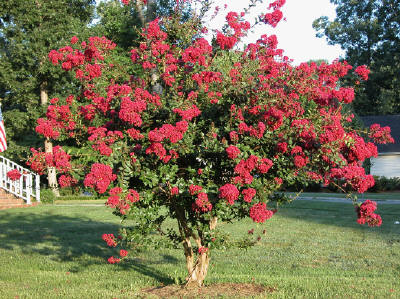|
Relax and Enjoy a Crepe
Carolyn Black
Adams County Master Gardener
 Lagerstroemia, commonly known as Crepe Myrtle or Crape Myrtle, is a genus of around 50 species of deciduous and evergreen trees and shrubs. Crepe myrtles have been especially eye-catching and beautiful this summer in the Adams County region. They love hot
and humid growing conditions, so they were very happy this summer. They are a terrific, low-maintenance choice for any landscape because of their prolific, colorful blooms. One of the prominent features of a crepe myrtle is the spectacular flowers which range from six to eight inches in length and three to five inches in width. The petals have a crinkled appearance,
similar to crepe paper, hence the name crepe myrtle. There are various flower colors available to the gardener, including white, lavender, purple, pink, magenta, and red. Lagerstroemia, commonly known as Crepe Myrtle or Crape Myrtle, is a genus of around 50 species of deciduous and evergreen trees and shrubs. Crepe myrtles have been especially eye-catching and beautiful this summer in the Adams County region. They love hot
and humid growing conditions, so they were very happy this summer. They are a terrific, low-maintenance choice for any landscape because of their prolific, colorful blooms. One of the prominent features of a crepe myrtle is the spectacular flowers which range from six to eight inches in length and three to five inches in width. The petals have a crinkled appearance,
similar to crepe paper, hence the name crepe myrtle. There are various flower colors available to the gardener, including white, lavender, purple, pink, magenta, and red.
Crepe myrtles bloom in midsummer until frost. I have a lovely pink crepe myrtle, lagerstroemia ‘Choctaw", that is fourteen years old and a beautiful red crepe myrtle, lagerstroemia indica ‘Red Cherokee’, which is four years old. The red crepe myrtle was purchased at a nursery when our family vacationed at the Outer Banks in
North Carolina. Crepe myrtles are very prevalent and prolific in the south, but most varieties will do well in our area if they are somewhat protected.
Crepe myrtles are native to the Indian subcontinent, Southeast Asia, Northern Australia and parts of Oceania. The common crepe myrtle from China and Korea was introduced circa 1790 to Charleston, South Carolina by the French botanist Andre Michaux. Two hundred years of cultivation has resulted in a huge number of cultivars of widely
varying characteristics.
The lovely crepe myrtle even has Biblical notoriety in Isaiah 55: 13 - "Instead of the thorn bush will grow the pine tree; and instead of briers the myrtle will grow."
 After blooming, crepe myrtles develop distinctive seed heads, then the leaves fall toward the end of autumn, leaving the colorful, exfoliating bark to showcase during the winter. After blooming, crepe myrtles develop distinctive seed heads, then the leaves fall toward the end of autumn, leaving the colorful, exfoliating bark to showcase during the winter.
All species of crepe myrtle are woody in nature and can range in height from one foot to over one hundred feet. The timber of some species has been used to manufacture bridges and furniture. The leaves of Lagerstoemia parviflora are fed on by the Antheraea paphia moth which produces the tassar silk, a form of wild silk of
commercial importance in India.
When choosing crepe myrtles for your landscape, there are several factors to consider including: height, natural shape (shrub vs. tree), flower color, amount of bark exfoliation, and disease resistance. The best decision about the size of your crepe myrtle is made when you purchase it. Buy the right variety to fit the space!
Ideally, crepe myrtles should be planted in cool weather, when they are dormant. They require thorough watering for about two months after they are planted. Once they are established, they can tolerate quite a bit of drought. Crepe myrtles flower best in full sun for at least six hours per day. They do well in almost any kind of soil as
long as it is well-drained. The ideal pH is 5.0 – 6.5.
Crepe myrtles benefit from annual feeding with a general-purpose or high nitrogen fertilizer in early spring. Take advantage of the toughness of these plants. Too much fertilizer can actually result in excessive leaf growth and fewer blooms.
The most common disease of crepe myrtles is powdery mildew. This can be prevalent during hot, humid days followed by cool, dewy nights. If your crepe myrtle shows signs of powdery mildew, treat it with a general fungicide.
Crepe myrtles bloom on this year’s growth (new wood), so prune during late winter before growth starts. Early autumn pruning can result in a quick growth response that prevents dormancy and makes winter freezes potentially deadly. Even if a severe winter kills most of the top growth on your crepe myrtle, it is capable of growing back in a
short time. Since they bloom on new growth, the injured plants are able to produce flowers as well.
Crepe myrtles are a wonderful accent to a landscape. They are relatively maintenance free. They are tough plants so don’t kill them with kindness. Instead, relax with a glass of iced tea and enjoy their beauty!
Read other articles about trees & tree care
Read other articles by Carolyn Black
|